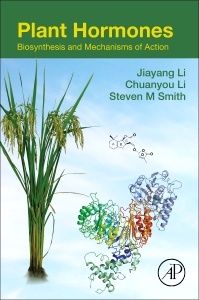Description
Hormone Metabolism and Signaling in Plants
Authors: Li Jiayang, Li Chuanyou, Smith Steven M
Language: English
Subjects for Hormone Metabolism and Signaling in Plants:
Keywords
Abiotic stress; Abscisic acid; ACO; ACS; Adenylate isopentenyltransferase; Arabidopsis thaliana; Arabidopsis; Auxin biosynthesis; Auxin signaling; Auxin transport; Auxin; Bioassay; Biosynthesis; Biosynthetic pathway; Brassinosteroids; Cell differentiation; Cleavage; COI1; Cross talk; CTR1; Cytokinin oxidase; Cytokinin; Defense response; Defense responses; DELLA; Detection; Development; EBF1/EBF2; Effector-triggered immunity; EIN2; EIN3/EIL1; Ethylene; Extraction; Gibberellins; GID1; Growth and development; His kinase; Hormone biosynthesis; Hormone receptors; Hypersensitive response; IAA conjugation; Indole-3-acetic acid (IAA)Integrative GA signaling; JA-Ile; Jasmonate biosynthesis; Jasmonate signaling; Jasmonates; JAZ; LC-MS/MS; Liquid chromatography; LRR-receptor kinases; Mass spectrometry; Meristem maintenance; Metabolism; MHZ6; MHZ7; Modifications; Nodulation; Nonexpresser of pathogenesis-related protein 1; PAMP (pathogen-associated molecular pattern)-triggered immunity; Parasitism; Peptide hormones; Perception; Phosphoryl transfer; Phytohormone; Plant genetics; Plant growth and adaptation; Plant hormones; Plant; Pluripotency; Processing; Purification; Quantification; Quantitative analysis; Receptors; Regeneration; Reproductive processes; Rice; Root apical meristem; Salicylic acid; Sample preparation; Shoot apical meristem; Shoot branching; Signal transduction; Signaling; Stem cell; Stomata development; Stress response; Strigolactones; Symbiosis; Systemic acquired resistance; Transcription; Transcriptional regulation; Translational repression; Transport proteins; Transport; Two-component system
94.99 €
In Print (Delivery period: 14 days).
Add to cartSupport: Print on demand
Description
/li>Contents
/li>Readership
/li>Biography
/li>Comment
/li>
Plant Hormones: Biosynthesis and Mechanisms of Action is based on research funded by the Chinese government?s National Natural Science Foundation of China (NSFC). This book brings a fresh understanding of hormone biology, particularly molecular mechanisms driving plant hormone actions. With growing understanding of hormone biology comes new outlooks on how mankind values and utilizes the built-in potential of plants for improvement of crops in an environmentally friendly and sustainable manner.
This book is a comprehensive description of all major plant hormones: how they are synthesized and catabolized; how they are perceived by plant cells; how they trigger signal transduction; how they regulate gene expression; how they regulate plant growth, development and defense responses; and how we measure plant hormones.
This is an exciting time for researchers interested in plant hormones. Plants rely on a diverse set of small molecule hormones to regulate every aspect of their biological processes including development, growth, and adaptation. Since the discovery of the first plant hormone auxin, hormones have always been the frontiers of plant biology.
Although the physiological functions of most plant hormones have been studied for decades, the last 15 to 20 years have seen a dramatic progress in our understanding of the molecular mechanisms of hormone actions. The publication of the whole genome sequences of the model systems of Arabidopsis and rice, together with the advent of multidisciplinary approaches has opened the door to successful experimentation on plant hormone actions.
1. Hormone function in plants 2. Auxins 3. Cytokinins 4. Gibberellins 5. Abscisic acid 6. Ethylene 7. Jasmonates 8. Salicylic acid 9. Brassinosteroids 10. Strigolactones 11. Peptide hormones 12. Plant hormones and stem cells 13. Phytohormonal quantification based on biological principles 14. Quantitative analysis of plant hormones based on LC-MS/MS
Graduate students, Post-Doctoral researchers, researchers in plant sciences, molecular biologists, botanists and those in horticultural/forestry/agricultural sciences.
Dr. Chuanyou Li received his Ph. D. in Genetics at the Institute of Genetics, Chinese Academy of Sciences (CAS) in 19
- Offers a comprehensive description of all major plant hormones including the recently discovered strigolactones and several peptide hormones
- Contains a chapter describing how plant hormones regulate stem cells
- Offers a fresh understanding of hormone biology, particularly molecular mechanisms driving plant hormone actions
- Discusses the built-in potential of plants for improvement of crops in an environmentally friendly and sustainable manner




